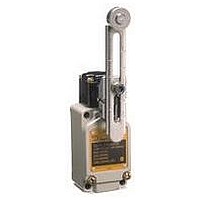D4BL-K3 Omron, D4BL-K3 Datasheet - Page 12

D4BL-K3
Manufacturer Part Number
D4BL-K3
Description
Contact OSTI For Purchase
Manufacturer
Omron
Type
Safety-Door Switchr
Series
D4BLr
Specifications of D4BL-K3
Contact Form
DPDT
Contact Rating
10 Amps
Actuator
Plunger
Operating Force
19.61 N
Termination Style
Wire
Color
Red
Mounting Style
Screw
Lead Free Status / RoHS Status
Lead free / RoHS Compliant
For Use With
D4BL Guard Lock Safety Door Switches
Lead Free Status / Rohs Status
Lead free / RoHS Compliant
Other names
Q2025725A
Precautions
J NOTICE
Be sure to mount the Operation Key so that it will not come into
contact with the human body, or injury may result.
If the D4BL is applied to an emergency stop circuit or safety
circuit for prevention of injury, use the NC contact, which has a
force-separation mechanism, and make sure that the D4BL
operates in the positive mode. Furthermore, secure the D4BL
with screws or equivalent parts that are tightened in a single
direction so that the D4BL or Operation Key cannot be easily
removed, or install a protection cover for the D4BL and post a
warning label near the D4BL.
In order to protect the D4BL from damage due to short-circuiting,
connect a fuse breaking a current 1.5 to 2 times higher than the
rated current in parallel with the D4BL.
If an application satisfying EN standards is to employ the D4BL,
apply a 10-A gI or gG fuse approved by IEC269.
In order to prevent the D4BL from burning due to overvoltage,
insert a protection fuse into the solenoid circuit.
If the D4BL is imposed with force exceeding the lock strength,
the D4BL may break and the equipment may continue to operate.
Auxiliary Release Key
The auxiliary release key is used to unlock the D4BL in case of
emergency cases or in case the power supply to the D4BL fails.
Use an appropriate tool to set the auxiliary release key to
UNLOCK so that the lock will be released and the door can be
opened.
The auxiliary release key applied to the door of a machine room
ensures the safety of people adjusting the equipment in the
machine room. If the auxiliary release key is set to UNLOCK, the
door will not be locked when the door is closed and no power will
be supplied to the equipment.
UNLOCK
Do not insert the Operation Key into the key hole while the
protective door is open. Before using the machine, be sure to
remove the shock-absorbing damper, which is provided before
shipping. Otherwise the machine will operate, and injury may
result.
LOCK
Auxiliary
release key
!
CAUTION
13
To lock the door, set the auxiliary release key to LOCK.
Do not use the auxiliary release key to start or stop machines.
To prevent the auxiliary release key from being handled
carelessly by unauthorized people, seal the auxiliary release key
with sealing wax and the provided seal cap to ensure IP67.
Make sure that the auxiliary release key is kept with the person in
charge.
Before attaching the cover to the D4BL, make sure that the
auxiliary release key position is set to LOCK.
Mount with a Stopper
J CORRECT USE
Operating Environment
Due to the wear and tear of the sealing of the D4BL, water and
some types of oil and chemical sprayed onto the D4BL may
cause contact or insulation failures, current leakages, or fires.
Do Not Use the D4BL in the Following Places
•
•
•
•
Places with radical temperature changes.
Places with excessive humidity that may cause condensa-
tion.
Places with excessive vibration.
Places where metal dust, oil, or chemical may be sprayed
onto the D4BL.
Switch
Stopper
Do not apply the D4BL to
the door of a machine
room without applying a
stopper to the door. If ex-
cessive force is imposed
on the D4BL, the lock
mechanism may break
and the equipment in the
machine room may start
to operate.
D4BL







